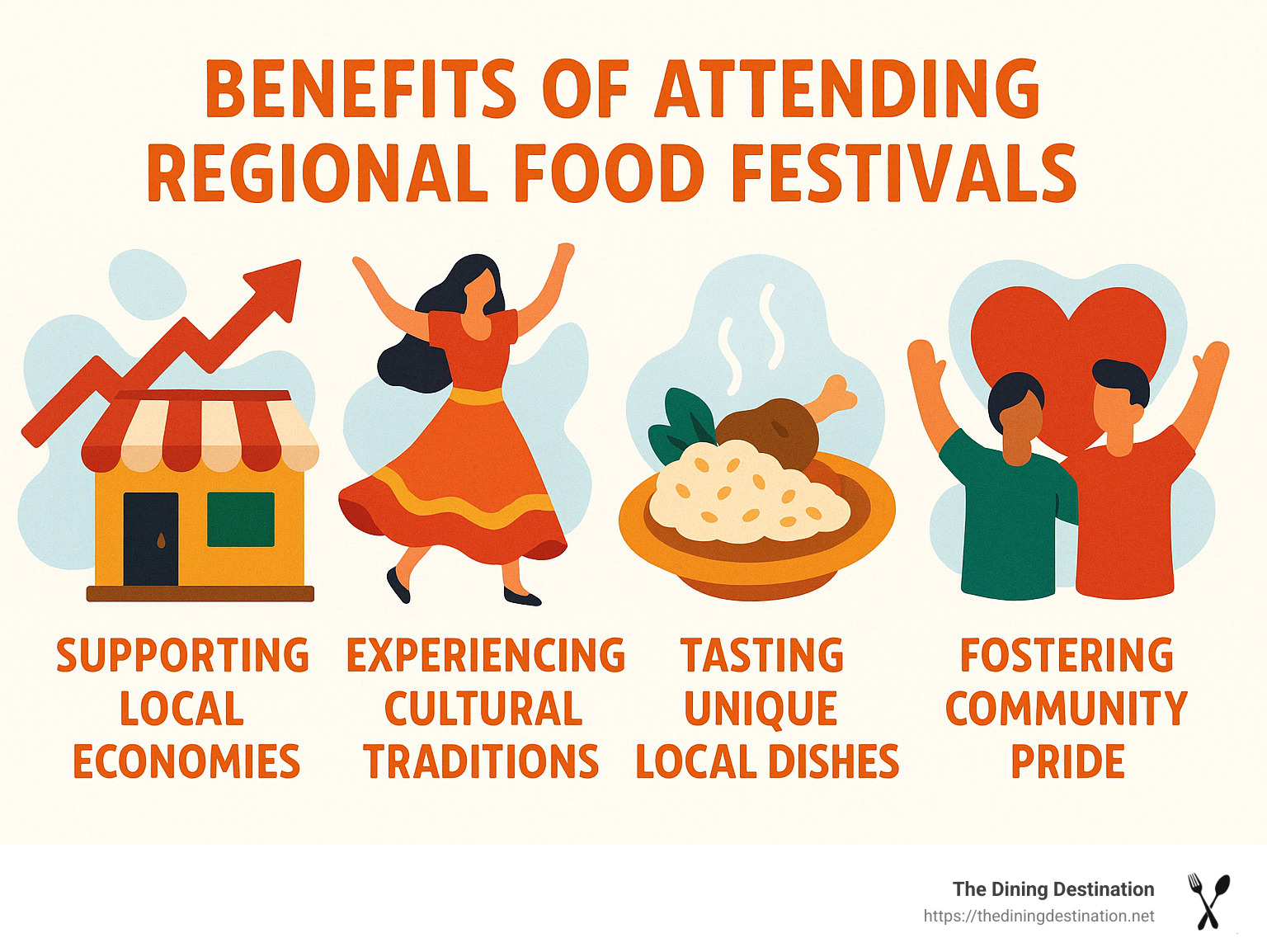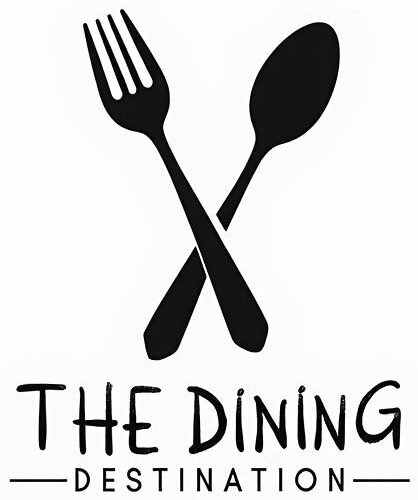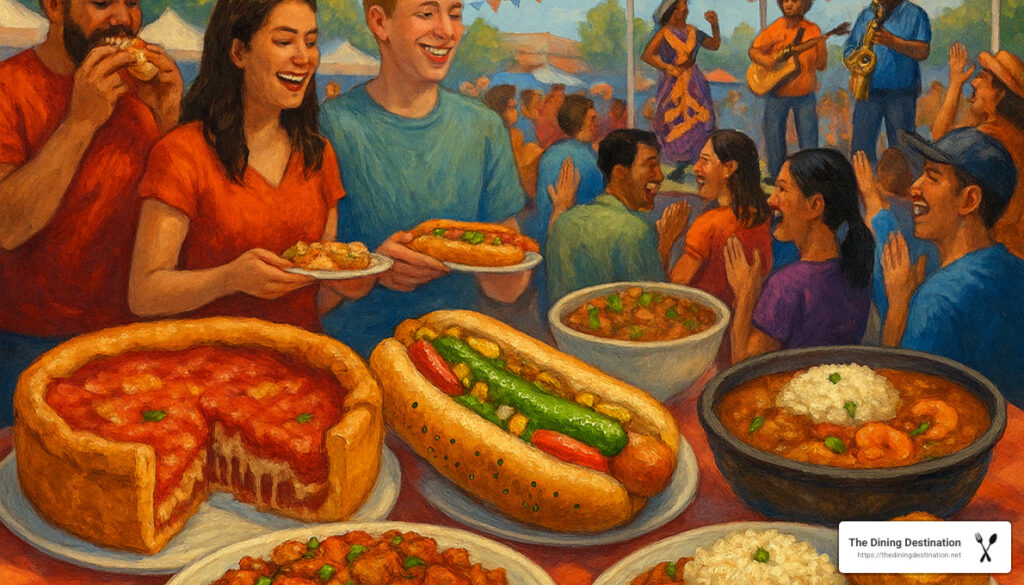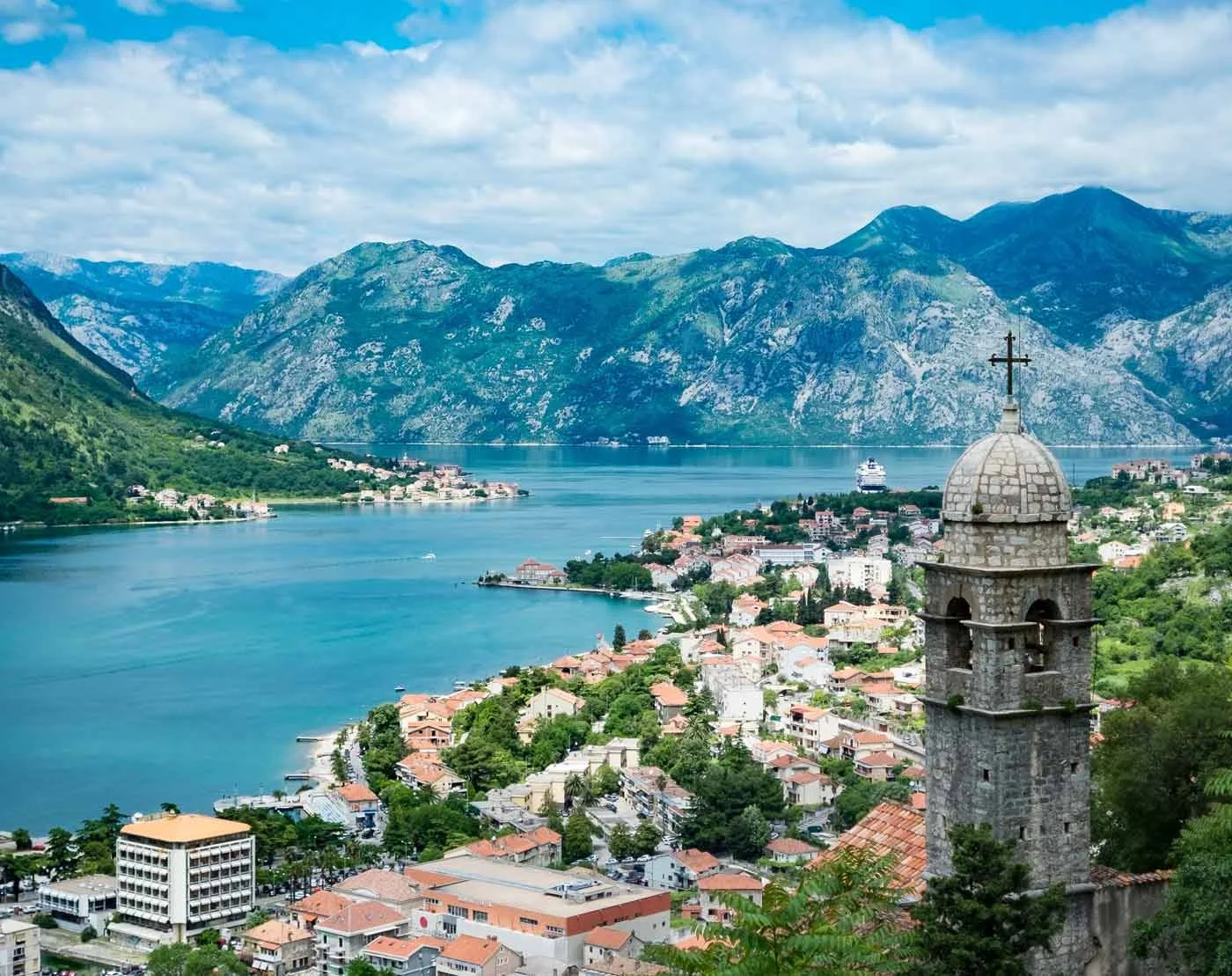Find the Best Regional Food Festivals Around You
Regional food festivals offer foodies the perfect opportunity to savor local specialties, enjoy cultural performances, and support community traditions. If you’re in a hurry, here are some top events worth checking out:
- Taste of Chicago – Deep-dish pizza, Chicago-style hot dogs (July)
- South Beach Wine & Food Festival, Florida – Celebrity chefs, wine tastings (February)
- New Orleans Wine and Food Experience – Cajun and Creole cuisines (May)
- Gilroy Garlic Festival, California – Garlic-infused dishes, culinary heritage (July)
- Maine Lobster Festival – Fresh seafood, lobster dishes (August)
Attending these festivals means experiencing the true heart of a place, its traditions, and its people. These events go beyond eating—they help sustain local producers, boost regional economies, and celebrate cultural heritage.
Here’s a quick infographic summarizing why attending regional food festivals is valuable:

The Importance of Regional Food Festivals
Regional food festivals are so much more than a delicious way to spend your weekend. They’re vibrant celebrations of cultural heritage, bringing together communities to honor their unique culinary traditions. Through these festivals, age-old recipes and traditional cooking methods get passed down to generations, preserving a vital part of regional identity. Let’s face it—grandma’s famous pie recipe needs all the protection it can get!
Beyond the joy of tasting incredible dishes, these festivals have a substantial economic impact on their communities. Did you know that in the United States alone, there are over 8,000 local food festivals each year? Florida itself hosts hundreds annually, creating significant revenue streams for local farmers, producers, restaurants, and hotels. Take the Tampa Bay Wine and Food Festival, for instance—it attracts around 7,000 food lovers every year, featuring more than 50 well-known chefs and restaurants. This kind of event means big business for local economies, benefiting everyone from growers to gourmet chefs.
But it’s not just about the dollars—it’s about the sense of belonging and community unity these festivals nurture. People from all backgrounds gather around tables brimming with tasty local dishes, sharing laughs, stories, and cultural pride. One festival organizer said it best: “Festivals are great family events that preserve food history and unite communities.” Even Erik Wolf, Executive Director of the World Food Travel Association, emphasizes that “Certified culinary tourist guides are essential for delivering the depth of knowledge that food enthusiasts crave today.”
Another wonderful benefit of these events is their role in promoting local produce and sustainable food practices. By showcasing locally grown ingredients and traditional preparation methods, festivals encourage attendees to support nearby farmers and producers. This farm-to-table approach doesn’t just result in fresher, tastier meals—it also helps reduce the carbon footprint associated with transporting food from faraway places.
At The Dining Destination, we’ve seen how these regional gatherings are deeply connected to broader trends in food tourism. As explored in our article How Food Tourism is Changing the Way We Travel, approximately 93% of leisure travelers now pick destinations based on culinary reputation. Food tourism is booming, with the global market valued at nearly US$1 trillion today and projected to triple by 2032.
Clearly, regional food festivals play a crucial role—not just by giving us tasty treats, but by celebrating our heritage, supporting local communities, and encouraging sustainable practices. So next time you bite into a funnel cake or sample locally-made cheese at a festival, remember—you’re tasting history, culture, and community, all wrapped up in one delicious bite!
Top Regional Food Festivals That Celebrate Local Flavors
1. Taste of Chicago, Illinois: A Regional Food Festival Extravaganza
When it comes to regional food festivals, the Taste of Chicago is in a league of its own. What began as a modest gathering in 1980 now attracts roughly 3 million visitors annually, changing Chicago’s Grant Park into a giant, delicious outdoor buffet.

At the Taste of Chicago, iconic dishes reign supreme. You can’t visit without digging into a slice (or three) of Chicago’s famous deep-dish pizza—thick, cheesy, and deliciously hearty. Locals love debating which pizzeria serves the best version, so don’t forget to pick your favorite too!
Then there’s the legendary Chicago-style hot dog. Forget ketchup—these loaded dogs come piled high with mustard, neon-green relish, onions, sport peppers, tomato, pickle spears, and a sprinkle of celery salt, all served on a fluffy poppy seed bun. It’s essentially a salad, right?
Beyond these famous classics, the festival celebrates other hometown favorites, including Italian beef sandwiches dripping with savory juices, smoky Maxwell Street Polish sausages, and Eli’s Cheesecake. Plus, with lively music, cooking demos, and activities perfect for families, the Taste of Chicago truly captures the spirit of this vibrant city.
2. South Beach Wine & Food Festival, Florida: A Coastal Regional Food Experience
If there’s one event that could be called the “Super Bowl” of regional food festivals, it’s the South Beach Wine & Food Festival. Each February, Miami’s glamorous beaches welcome foodies for a five-day extravaganza featuring over 500 talented chefs and tastings from more than 75 wineries.
You might recognize a few faces here, as celebrity chefs regularly host cooking demos, exclusive dinners, and lively culinary competitions. Top events include the legendary Burger Bash, where you can taste—and vote for—your favorite juicy creation from America’s top chefs.
The festival mirrors Miami’s vibrant culture, showcasing the area’s incredible diversity. Expect everything from Latin-inspired feasts to freshly caught seafood delicacies, all served alongside premium wines at entertaining seminars and late-night parties.
Best of all, it’s for a good cause. The festival has raised over $30 million to support Florida International University’s Chaplin School of Hospitality & Tourism Management. So indulge freely—you’re dining for an excellent reason!
3. New Orleans Wine and Food Experience, Louisiana
No city celebrates flavor like New Orleans, and the New Orleans Wine and Food Experience (NOWFE) perfectly captures the excitement and passion behind Louisiana’s culinary traditions. Drawing around 10,000 food lovers annually since 1992, this event is a joyous celebration of Cajun and Creole cuisine.
From spicy crawfish étouffée and hearty gumbo to sweet, pillowy beignets, NOWFE reveals the delicious fusion of French, Spanish, African, and Caribbean influences that makes New Orleans food so unforgettable.
But the festival isn’t just about eating—it’s about experiencing New Orleans culture. Live jazz performances create the perfect backdrop, while events like the Royal Street Stroll let visitors casually explore the historic French Quarter, sampling wine and food in quaint galleries and boutique shops.
The Grand Tastings offer hundreds of wines carefully paired with dishes from New Orleans’ finest restaurants. What’s more, festival proceeds directly support local nonprofit organizations focused on food education and hunger relief, making NOWFE a tasty celebration with heart.
4. Gilroy Garlic Festival, California
Garlic lovers, rejoice! The Gilroy Garlic Festival in California has been delightfully celebrating the pungent bulb since 1979. Known as the “Garlic Capital of the World,” Gilroy hosts this aromatic event every July, attracting visitors eager to savor unique garlic-infused creations.

At this regional food festival, garlic is truly king. Imagine tasting garlic fries, garlic bread, and even garlic ice cream (yes, really!). Feeling adventurous? Give garlic chocolate or garlic cotton candy a try—it’s surprisingly tasty and makes a great story.
The festival’s main attraction is “Gourmet Alley,” an outdoor kitchen where “Pyro Chefs” wow the crowds, cooking garlic calamari and scampi over spectacular flames. Amateur cooks also face off at the Great Garlic Cook-Off, competing fiercely to create the best garlic dish.
Beyond the food, this festival is all about community, tradition, and fun. Over the decades, it has raised millions for local nonprofits, highlighting the powerful role that something as humble as garlic can play in community unity and pride.
5. Maine Lobster Festival, Maine
For seafood fans, the Maine Lobster Festival is a “pinch-me” kind of event. Held in Rockland every August, this beloved tradition celebrates Maine’s famous lobster and its rich maritime heritage, drawing about 30,000 visitors every year.
The festival serves up fresh, succulent lobster dishes—everything from steamed lobster dripping in drawn butter to mouthwatering lobster rolls, creamy lobster bisque, and savory lobster mac and cheese. Volunteers cook thousands of pounds of lobster using what the festival claims is the world’s largest lobster cooker, making it an unforgettable feast.
But lobster isn’t the only attraction. The festival brings Maine’s maritime culture to life through events like the colorful Maine Sea Goddess Pageant and the entertaining lobster crate race, where participants daringly race across floating crates. The Big Parade, featuring local bands and festive floats, adds a cheerful community spirit to the festivities.
Visitors can browse beautifully handcrafted goods from local artisans celebrating Maine’s nautical heritage, participate in cooking competitions, or explore informative exhibits about lobstering and conservation.
Most importantly, the Maine Lobster Festival connects visitors directly with the working waterfront, introducing them to the hardworking lobstermen and women who make it all possible. It’s not just eating lobster—it’s gaining a deeper appreciation of the people and culture behind Maine’s iconic seafood.
Must-Visit Regional Food Festivals Around the World
1. Alba White Truffle Fair, Italy
Nestled in Italy’s picturesque Piedmont region, the Alba White Truffle Fair (Fiera Internazionale del Tartufo Bianco d’Alba) stands as a temple to one of gastronomy’s most precious treasures. This prestigious regional food festival transforms the medieval town of Alba into a gourmet paradise each year from October to December, drawing food lovers from every corner of the globe.
The star of the show is, of course, the elusive white truffle – a culinary gem that can fetch thousands of dollars per pound. Unlike their black cousins, white truffles stubbornly resist cultivation, requiring skilled foragers and their four-legged companions to sniff them out from their hiding places beneath the forest floor. This natural rarity only improves their mystique and value.
Wandering through the festival’s truffle market is a sensory delight. Licensed traders display their aromatic “white diamonds” alongside other regional specialties, the distinctive musky scent filling the air. The atmosphere buzzes with excitement as chefs and connoisseurs carefully select these earthy treasures for their kitchens.
Perhaps the most enchanting aspect of the fair is witnessing the traditional truffle hunt demonstrations. Specially trained dogs (who have largely replaced pigs in modern times, as they’re less likely to devour the valuable finds!) work in perfect harmony with their handlers, showcasing a centuries-old practice that remains largely unchanged by time or technology.
Beyond truffles, the festival celebrates the broader culinary heritage of Piedmont. The region’s renowned hazelnuts, artisanal cheeses, and prestigious wines like Barolo and Barbaresco take center stage in cooking workshops, wine tastings, and special dinners that highlight how these ingredients dance together in traditional recipes.
What makes the Alba White Truffle Fair truly special is how it preserves not just flavors but knowledge. By honoring traditional foraging practices and sustainable harvesting methods, the festival helps maintain the delicate forest ecosystems where truffles thrive, ensuring this unique gastronomic tradition continues for generations to come.
2. Yilan International Green Onion Festival, Taiwan
While some regional food festivals celebrate rare delicacies with eye-watering price tags, others prove that even the humblest ingredients can become stars in their own right. The Yilan International Green Onion Festival in Taiwan’s northeastern county perfectly illustrates how a simple allium can bring an entire community together in celebration.

Yilan’s unique soil and climate conditions produce green onions (scallions) that are something of a local treasure – thicker, juicier, and more aromatic than typical varieties. These exceptional qualities have made them a defining ingredient in regional Taiwanese cuisine and the perfect centerpiece for a vibrant cultural festival.
The culinary creativity on display is genuinely impressive. Festival-goers can sample everything from traditional favorites like crispy green onion pancakes and delicate onion dumplings to surprising innovations including green onion ice cream and refreshing onion-infused beverages. Each dish showcases the versatility of this humble ingredient in ways that surprise and delight visitors.
What makes this festival particularly charming are the playful, onion-themed activities that invite participation. Visitors roll up their sleeves for green onion pulling contests, test their skills in pancake-making challenges, and compete in quirky games that celebrate local agriculture with a healthy dose of humor.
Throughout the festival, traditional Taiwanese music and dance performances provide a cultural backdrop, connecting the farming heritage of the region with its artistic identity. Educational displays offer insights into the cultivation techniques that have been refined over generations, highlighting the importance of preserving these agricultural traditions.
The Yilan International Green Onion Festival beautifully demonstrates how regional food festivals can transform everyday ingredients into sources of community pride while supporting local farmers and preserving valuable agricultural knowledge. It reminds us that sometimes the most meaningful celebrations center around the simplest foods.
3. Hokkaido Seafood Festivals, Japan
Japan’s northernmost island of Hokkaido is a seafood lover’s paradise, blessed with pristine waters that produce some of the world’s most coveted marine delicacies. Throughout the year, various regional food festivals honor this incredible aquatic bounty, with each season bringing different specialties to the spotlight.
The cold, nutrient-rich waters surrounding Hokkaido yield seafood that Japanese chefs and connoisseurs prize for its exceptional sweetness and firm texture. From succulent king crab and buttery sea urchin to glistening salmon, tender squid, and plump scallops, the diversity of offerings reflects the island’s remarkable marine biodiversity.
One standout event is the Sapporo Autumn Fest in September, which transforms the capital city into a celebration of Hokkaido’s coastal bounty. Local chefs practice a philosophy of minimal intervention, allowing the natural flavors of just-caught seafood to shine through. The result is cuisine that feels both neatly simple and profoundly luxurious.
These festivals offer more than just exceptional eating. Visitors can watch fishermen demonstrate traditional techniques honed over generations, offering a window into sustainable practices that respect the sea’s abundance while ensuring its future. The journey from ocean to plate becomes a story told through demonstrations, with fish-cutting spectacles and seafood auctions providing both entertainment and education.
For the truly curious, some festivals even offer boat tours to fishing grounds, allowing visitors to connect more deeply with the source of their meal. This immersive approach helps build appreciation for the challenging work of Hokkaido’s fishing communities and the pristine environments they depend upon.
The cultural dimension of these festivals extends to honoring the traditions of Hokkaido’s indigenous Ainu people, whose deep connection to the island’s natural resources spans thousands of years. Traditional Ainu performances, crafts, and culinary techniques add meaningful depth to the celebrations, acknowledging the original stewards of these bountiful waters.
Through these joyful celebrations, Hokkaido’s seafood festivals create connections between visitors, fishing communities, and the natural environment, embodying the holistic approach to food that makes Japanese cuisine so beloved worldwide.
4. Fête du Piment d’Espelette, France: A Spicy Regional Food Festival
In the rolling hills of France’s Basque country, the quaint village of Espelette transforms each October into a vibrant celebration of its famous crimson treasure. The Fête du Piment d’Espelette (Espelette Pepper Festival) ranks among France’s most distinctive regional food festivals, honoring the pepper that has become synonymous with Basque culinary identity.
The Espelette pepper’s story stretches back to the 16th century when it was first cultivated in this picturesque corner of southwestern France. Today, it enjoys the prestigious AOC (Appellation d’Origine Contrôlée) designation, ensuring that only peppers grown in this specific microclimate according to traditional methods can bear the Espelette name. These moderately spicy peppers are harvested as autumn approaches, then fashioned into decorative garlands called “cordes” that adorn the whitewashed facades of village homes – creating a postcard-perfect scene that draws visitors from far and wide.
During the festival weekend, Espelette’s narrow streets come alive with color and flavor. Local producers proudly offer tastings of an astonishing array of pepper-infused creations – from savory oils and vinegars to spiced cheeses, chocolate, honey, and even pepper liqueurs. Cooking demonstrations reveal the pepper’s versatility in classic Basque dishes like piperade (a sautéed mixture of peppers, onions, and tomatoes) and axoa (a flavorful veal stew).
What makes this festival truly special is how it weaves together food, faith, and community. The traditional blessing of the peppers at the village church reflects the deep spiritual connections that underpin agricultural life in the region. Meanwhile, Basque cultural expressions – from spirited folk music and traditional dance performances to demonstrations of pelota (the lightning-fast traditional ball game) – create a complete cultural immersion.
The Fête du Piment d’Espelette beautifully illustrates how a single agricultural product can become the foundation of a region’s culinary reputation and economic vitality. By celebrating this distinctive pepper, the festival helps preserve traditional farming methods while introducing visitors to the rich cultural mix of Basque country.
For more international culinary celebrations, check out our guide to Top Food Festivals Around the World Worth Traveling For.
5. International Mango Festival, India
When summer heat blankets Delhi in July, the city erupts in a jubilant celebration of what many Indians affectionately call the “king of fruits.” The International Mango Festival stands as one of India’s most beloved regional food festivals, a two-day extravaganza that showcases the country’s astonishing mango diversity with over 500 varieties from across the subcontinent and beyond.
For first-time visitors, the sheer variety on display can be mind-boggling. Beyond the internationally famous Alphonso with its honeyed perfume and the Dasheri with its distinctive flavor, the festival introduces lesser-known regional treasures like the Langra, Chausa, and Neelam. Each variety offers a unique sensory experience – some aromatic, others surprisingly tangy, some with fibrous flesh, others with buttery smoothness. Together, they represent an extraordinary catalog of biodiversity, many varieties rarely seen outside their growing regions.
The festival’s culinary competitions transform the humble mango into everything imaginable. Talented chefs craft innovative mango curries, tangy chutneys, decadent desserts, refreshing beverages, and surprisingly delicious savory dishes. Cooking demonstrations provide practical knowledge for home cooks eager to incorporate mangoes into their repertoire beyond the typical desserts and smoothies.
Folk performers from different mango-growing regions of India add cultural richness to the celebration through traditional music and dance, connecting the fruit to its regional contexts. Meanwhile, art exhibitions featuring mango-themed works highlight how deeply this beloved fruit has penetrated Indian aesthetics and symbolism over centuries.
Beyond the sensory pleasures, the festival serves a vital educational purpose. Farmers and agricultural experts share valuable knowledge about mango cultivation, variety preservation, and sustainable farming practices. This exchange helps preserve traditional growing methods while introducing innovations that can help farmers adapt to changing climate conditions – ensuring that India’s remarkable mango heritage continues to thrive.
The International Mango Festival reminds us that food biodiversity is worth celebrating and protecting. In an era of agricultural standardization, these hundreds of unique mango varieties represent not just different flavor profiles but different cultural histories, agricultural practices, and ecological adaptations – a living library of taste and tradition that deserves to be preserved for future generations.
Tips for Experiencing Regional Food Festivals
Attending regional food festivals can be an incredibly rewarding experience—but they can also feel overwhelming if you dive in unprepared. To help you savor every delicious moment, here are some tried-and-true tips to make the most of your culinary trips.
Planning Ahead
Before you head out, take a little time to research your festival of choice. Look into what vendors will be there, special dishes you might want to try, and any events or demonstrations that catch your eye. Many festivals offer limited-edition dishes or unique workshops that fill up quickly, so booking these in advance can make your experience more enjoyable.
As one seasoned organizer wisely said, “The best way to experience a food festival is to arrive with a plan, but always leave room for spontaneity. Know your must-try dishes, but stay open to unexpected finds.”
Additionally, considering buying tickets online ahead of time. Festivals such as the South Beach Wine & Food Festival often provide early bird discounts or VIP packages. These special tickets can include reserved seating, exclusive tastings, and other perks to improve your experience.
Engaging with Locals
Part of the joy of attending regional food festivals is the connection you make with the local community. Strike up conversations with vendors, chefs, and fellow food lovers. You’ll often find fascinating stories behind recipes, ingredients, and cooking techniques.
A visitor once beautifully put it, “Food is more than sustenance—it’s culture, memory, and identity on a plate.” By chatting with locals, you gain deeper insight into the dishes you’re tasting and the history behind them.
Consider joining cooking demonstrations or hands-on workshops. These experiences aren’t just fun—they immerse you directly in local culinary traditions. From truffle hunting demonstrations at Italy’s Alba White Truffle Fair to making green onion pancakes in Taiwan, these workshops transform simple tasting into memorable experiences.
Trying Unique Dishes
Regional food festivals provide a perfect opportunity to push your culinary boundaries. Challenge yourself to taste at least one dish you’ve never encountered before. Maybe it’s garlic ice cream at California’s Gilroy Garlic Festival or spicy pepper-infused chocolate in the French village of Espelette. You might just find your new favorite treat!
And don’t forget—sharing is caring (and practical!). When attending a festival with friends or family, split dishes so you can sample a wider variety without getting overly full or breaking your budget.
Keep track of memorable dishes by snapping photos or jotting them down in a food journal. This way, you can recreate favorites at home or seek out similar foods in future travels.
Attending Workshops
Many festivals offer more than just tasty food—they provide valuable learning opportunities. Workshops and demonstrations can introduce you to skills that last long after the festival ends.
Imagine joining a seafood cooking session at Hokkaido’s Seafood Festivals, finding how to pair wines with Creole dishes in New Orleans, or learning the traditional craft of making lobster rolls in Maine. These educational experiences lift your festival visit from passive tasting to active learning—and leave you equipped with new culinary knowledge for your next dinner party.
Supporting Local Producers
Food festivals are a lifeline for small-scale, passionate producers who might not otherwise reach a broad audience. When you buy directly from them, you’re supporting local economies, preserving culinary traditions, and helping sustain regional agriculture.
Consider picking up edible souvenirs such as handmade condiments, spices, preserves, or specialty ingredients. These shelf-stable treats let you savor festival memories at home long after you’ve returned.
Don’t hesitate to ask vendors about their ingredients, sourcing practices, or production methods. Many are eager to share their passion for ethical production and sustainability. Your curiosity shows support for their hard work—and deepens your appreciation for the food you enjoy.

Frequently Asked Questions about Regional Food Festivals
What is the best time to attend regional food festivals?
The best time to attend regional food festivals really depends on what ingredients the region is celebrating and the local weather conditions. Most festivals are carefully timed to coincide with harvest seasons, ensuring visitors get to experience ingredients at their flavorful peak.
In the United States, you’ll find the greatest variety of festivals between June and October, as this is when fresh produce is abundant and outdoor dining is most comfortable. For instance, the much-loved Maine Lobster Festival happens each August, perfectly timed when lobsters are plentiful and at their freshest. Similarly, California’s Gilroy Garlic Festival kicks off in July, celebrating the garlic harvest season with plenty of delicious garlic-inspired dishes.
International events follow this seasonal trend, too. Italy’s famous Alba White Truffle Fair runs from October through December, highlighting the precious white truffle harvest. India’s International Mango Festival is held in July when mangoes are ripe, juicy, and abundant—perfect for tasting and cooking demonstrations.
Climate also plays an important role. Festivals in very hot climates usually happen during cooler months, while colder regions schedule their events in summer, offering visitors pleasant weather and enjoyable outdoor experiences. To get the most authentic experience, look into when locals typically visit. Popular festivals often attract large crowds, but local attendees usually know the best days or times for a relaxed and genuine experience.
How do regional food festivals benefit local communities?
Regional food festivals bring amazing economic and cultural benefits to local communities. They don’t just offer delicious food and fun—they create jobs, support local businesses, and strengthen community pride.
First, festivals generate direct economic gains. Attendees purchase tickets, sample dishes, and buy merchandise, directly benefiting local vendors, producers, and event organizers. But the economic impact doesn’t stop there. Festival-goers often stay overnight, eat at local restaurants, visit nearby attractions, and shop at local stores, spreading economic benefits throughout the whole community.
For example, Florida’s Tampa Bay Wine and Food Festival typically attracts around 7,000 visitors each year, providing a significant boost to area hotels, restaurants, and retailers. Similarly, the South Beach Wine & Food Festival has raised over $30 million to benefit the Florida International University Chaplin School of Hospitality & Tourism Management, showcasing how events can positively impact local education and community initiatives.
Beyond economic benefits, regional food festivals play an essential role in preserving culinary heritage. They offer a space where generations come together, sharing recipes, cooking techniques, and local history. This helps protect traditional foods from being lost to globalization and highlights sustainable local agriculture practices.
Lastly, festivals encourage cultural tourism. Visitors attending food festivals typically have a genuine interest in learning about local customs and culinary traditions. This makes cultural tourism more respectful and sustainable compared to mass tourism, fostering deeper connections between visitors and the communities they visit.
Are regional food festivals family-friendly?
Most regional food festivals warmly welcome visitors of all ages, offering plenty of family-friendly activities and features. However, the level of family-friendly amenities does vary, so it’s a good idea to check the festival’s website or social media before planning a family visit.
Larger festivals typically have dedicated children’s areas or family-friendly zones filled with activities, games, and entertainment designed specifically for kids. For example, the Taste of Chicago Festival has a Family Village with hands-on activities to keep the little ones engaged. Maine’s Lobster Festival includes quirky, kid-friendly events like the “Little Lobster Diaper Derby,” a crawling race that’s as adorable as it sounds. And the Gilroy Garlic Festival provides a special area for children’s crafts, games, and fun performances.
Food-wise, festivals often make sure there are kid-friendly dishes and snacks available, ensuring younger visitors have plenty of tasty options. Organizers typically understand that happy kids mean happy parents, and they plan accordingly.
Practical considerations for families are also important. Most festivals strive for stroller accessibility, provide baby-changing areas, and offer options for children with dietary restrictions or allergies. It’s always wise to research ahead, arrive early to beat the crowds, and pack essentials like sun protection, water, and snacks. Knowing the layout or identifying quieter areas in advance can also help make the experience more enjoyable for families with young children.
Conclusion
Regional food festivals offer much more than delicious bites—they provide a vibrant window into the heart and soul of local cultures. These special events invite us to explore authentic flavors, unique traditions, and the passionate communities that keep culinary heritage alive.

Whether you’re wandering through the massive, vibrant crowds at the Taste of Chicago, savoring iconic deep-dish pizza and Chicago-style hot dogs, or experiencing the fragrant, luxurious truffles at Italy’s Alba White Truffle Fair, you’ll find a world of culinary delights that go far beyond your average meal.
These festivals don’t just celebrate food—they celebrate community pride, local producers, and cultural preservation. They connect us directly with the farmers who grow ingredients, the chefs who prepare them, and the stories and traditions passed down through generations. In doing so, they create meaningful travel experiences that enrich us long after we’ve returned home.
At The Dining Destination, we firmly believe in the power of food tourism to transform travel. As we’ve explored in this article, attending regional food festivals lets us support local economies, helps preserve traditional practices, and provides unforgettable memories. It’s a sustainable, respectful form of travel that deepens our connections with the places we visit.
So, whether you’re planning your next big trip around a famous food festival or simply exploring exciting culinary events near home, we encourage you to seek out these gatherings.
Food is more than sustenance—it’s culture, memory, and identity on a plate.
Hungry for more inspiration? Check out our comprehensive guide to Find more culinary trips at The Dining Destination and start making delicious memories today.







